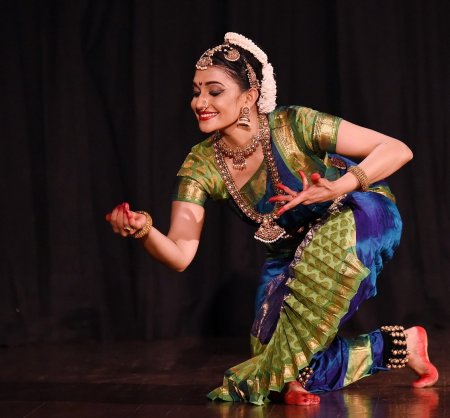Divya Ravi on her digital production Kanhopatra and dancing for the camera
Bharatanatyam dancer and choreographer Divya Ravi has been producing
some interesting content from her home during the lockdown. Along with
her Carnatic vocalist husband Dr. Sharan Subramaniam, she has produced
some made-for-camera pieces that explore the new medium to the fullest.
She is among the dancers I have seen in the past year who are not simply
filming stage presentations at home, but developing a new way of
thinking about choreography amid restrictions that make stage
presentations impossible.
One of her recent works is ‘Kanhopatra’, an abridged version of a
potentially full-length work about the Marathi courtesan-turned-Varkari
poetess Kanhopatra. I spoke to Divya about filming works like that, and
dancing for the camera.

Divya Ravi (Pic: Anoop Arora)
What happens to these short made-for-camera productions in a post-pandemic future?
Kanhopatra is a work in progress. And I do intend, at some point, to
build it into a full-fledged work for the stage –about an hour and 15
minutes. Right now, it’s only a 30-minute work. I have all the material
ready with me for the stage; because I had to do it in a digital format,
I had trimmed a lot of the content, mainly to reduce the time,
considering the digital attention spans of the audience. Even musically,
when I take it to the stage, it will be a full-fledged orchestra. So
far, we have only used the voice with no other instrument.
Most importantly, right now, it was dancing for the camera. So I have
had to really tone down my abhinaya bit, keep it more lokadharmi, keep
it as natural as possible. But of course, when it goes to the stage,
there will be a lot more nritta, because the entire premise is
Kanhopatra as a dancer. There is a lot more material, which I at this
point had to trim a bit. But when I do it for stage, I think there will
be a lot more coming in. As you said, I think now it is the hybrid age,
where we are trying to showcase work digitally as well as physically.
Even when we go back to stage . . . I’m sure the digital medium is here
to stay.
It also provides accessibility. I create this work in the UK, but I have
people from India to the US watching it. So even if they may not be
able to make it for the physical event at a later time, there’s always
the option of being able to watch it from wherever they are – at least
an abridged version.
What do you think about the difference in the space of a stage and the space that you get on the camera?
Definitely, it’s a huge difference. When I performed this in my house, I
had a limited space, so my movements have had to be tailored so that I
can fit it all into the camera frame. And then we’ve had to take some
close-up shots for abhinaya. So the choreography obviously, will be
very, very different when it comes on stage, your entire being and the
entire choreography will be largely different for stage. So even for me,
it’s going to be interesting to see how this develops, at whatever
point I want to take it on stage, how this develops from here
choreographically. Although the idea is there, the thought is there,
movement-wise, it’ll be quite a bit different.
When we are on stage, the entire feeling, the effect, is very different,
both for the performer and the audience. It’s a three-dimensional
effect, first of all, and then we are in that space, the space is so
charged with the energy of the performance. It’s a musical,
choreographic, spatial experience. But with the camera, all of that is
not possible. First, it’s two-dimensional. Second, musically, they’re
not able to experience that music as they would in the theatre, in the
physical space. So then, in some way, you do have to make use of these
technological bits, like the superimposing, layering, the subtitles – I
mean, it’s an advantage as well. Like I’m able to give subtitles when
it’s a full-on Marathi production and not many people know the language.
I’ve been able to do all of that with the digital space, of course.
Working with digital media had its advantages too.
Once it’s been digitally previewed, do you think you can travel with
the production? Will it take away from its scope for a tour?
I don’t think it would because right now, at least the way I have
devised Kanhopatra for the digital space, it’s only an abridged version.
It’s a half-hour piece, but when I take it to stage, it will definitely
be a longer one, it’ll be a more experiential one, there will be a lot
more to it. While many people from across the globe might have seen it,
what it will be when it goes on stage is something that only you can see
if you are physically in that space. I do think it has the scope to
tour because I’ve not put the full-length work out. Right now, it’s just
a glimpse into her world, this digital premiere, so even all the people
I know in Bengaluru who have watched it all said we have to see it on
stage now. It will be so lovely to see how it is when it goes on stage.
Note: This interview first appeared in narthaki.com.


Comments
Post a Comment